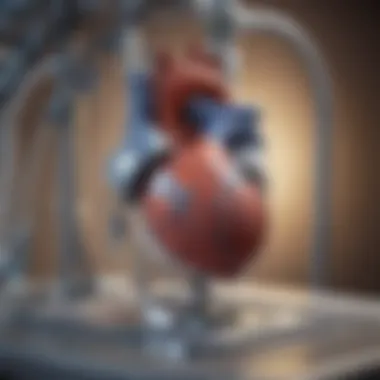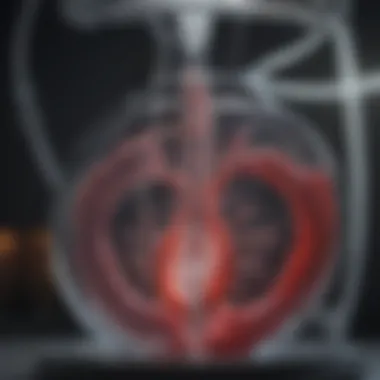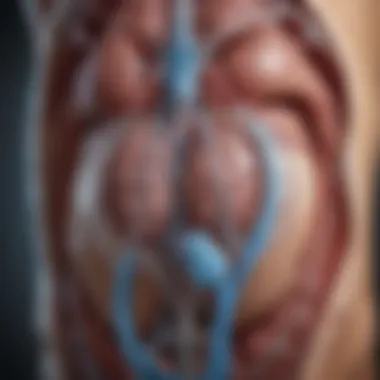Understanding Dialysis: A Comprehensive Overview


Intro
Dialysis represents a crucial component in the realm of renal care. For individuals suffering from kidney failure, this treatment offers a lifeline, facilitating the removal of toxins from the blood and maintaining fluid balance. There are two primary forms of dialysis: hemodialysis and peritoneal dialysis, each with distinct methodologies and implications for patient outcomes.
Understanding the complexity of dialysis is essential not only for medical professionals but also for patients and their families. This article aims to distill this knowledge, presenting clear insights into the equipment used, the procedures followed, and the real experiences of patients undergoing treatment. By examining both techniques, we can better appreciate the operational frameworks and the broader implications of dialysis on health and quality of life.
Research Overview
Methodological Approaches
Research into dialysis employs diverse methodologies, encompassing observational studies, clinical trials, and case reports. Such studies often focus on various outcomes, including the effectiveness of different dialysis methods, patient satisfaction, and long-term health effects. By synthesizing data from a range of sources, researchers can cultivate a deeper understanding of the treatment's efficacy and identify areas for improvement.
Significance and Implications
The significance of dialysis extends beyond mere survival; it profoundly impacts the quality of life. The treatment demands not only medical attention but also psychological and social support. Patients often navigate complex emotions and practical challenges associated with regular treatments, dietary restrictions, and lifestyle changes. Therefore, an informed public and healthcare community can better advocate for supportive resources and interventions.
Current Trends in Science
Innovative Techniques and Tools
Recent advances in dialysis technology include the development of portable dialysis machines and improved dialyzers that enhance patient comfort. Innovations such as wearable devices are emerging, aiming to monitor patients' health metrics in real time, facilitating more personalized care.
Interdisciplinary Connections
Dialysis research increasingly intersects with fields such as nutrition, psychology, and rehabilitative medicine. Understanding the interplay between diet and dialysis can enhance treatment efficacy, while addressing the psychological impacts is essential for holistic patient care. These interdisciplinary approaches can lead to improved outcomes and overall patient well-being.
"The evolution of dialysis not only illustrates advances in science but also underscores the vital need for comprehensive patient care."
In summary, dialysis is an ever-evolving field that continues to change lives for those affected by kidney disease. By exploring its nuances, we enhance the understanding of this significant medical intervention.
Preamble to Dialysis
Dialysis is an essential medical procedure for individuals facing kidney dysfunction. Understanding its nuances is crucial for both patients and healthcare professionals. This introduction lays the groundwork for a comprehensive exploration of dialysis, emphasizing its significance and relevance in modern medical care.
What is Dialysis?
Dialysis is a medical treatment that performs the critical functions of the kidneys when they are unable to do so. It removes waste products and excess fluid from the blood, ensuring a stable environment for biochemical processes within the body. The treatment involves two main types: hemodialysis and peritoneal dialysis. In hemodialysis, the blood is filtered outside the body through a machine, while peritoneal dialysis uses the lining of the abdomen to filter the blood. Both methods play a vital role in maintaining homeostasis for patients with kidney impairment.
This procedure is not a cure for kidney disease but serves as a life-sustaining measure that promotes better health and quality of life for individuals suffering from renal failure.
Importance of Dialysis in Medical Care
The importance of dialysis in medical care cannot be overstated. Here are several key aspects to consider:
- Life Preservation: For patients with end-stage renal disease, dialysis can be life-saving. It allows individuals to manage their symptoms and live longer, healthier lives.
- Patient Empowerment: Dialysis provides patients with the ability to control their health condition. Although the treatment requires lifestyle adjustments, it encourages active participation in managing kidney health.
- Comprehensive Care: Dialysis is often part of a holistic approach to treating renal disease. It can be supplemented with medication, dietary changes, and other interventions to optimize patient outcomes.
"Dialysis is not just a treatment; it is a pathway to better health and lifestyle adjustments for individuals with kidney challenges."
The integration of dialysis into patient care represents a significant advancement in nephrology, enhancing life quality and longevity. Understanding its role is critical for both patients and healthcare providers, paving the way for informed decisions regarding treatment options.
The Basics of Kidney Function
Understanding the basics of kidney function is vital when discussing dialysis. The kidneys perform multiple essential roles in the body. They balance electrolytes, regulate blood pressure, filter waste from the blood, and produce hormones that manage red blood cell production. A clear comprehension of these functions provides context for why dialysis becomes necessary when the kidneys fail to operate effectively.
Role of Kidneys in the Body
Kidneys are intricate organs that filter blood and produce urine. They maintain the body's ion concentration by adjusting levels of sodium, potassium, calcium, and phosphate. They also help regulate the pH level of blood by excreting hydrogen ions and reabsorbing bicarbonate.
Additionally, the kidneys are responsible for the secretion of important hormones. For instance, erythropoietin stimulates the bone marrow to produce red blood cells, especially when oxygen levels drop. Another hormone, renin, plays a significant role in managing blood pressure. Without proper kidney function, these processes falter, leading to various health issues.
Consequences of Kidney Failure


Kidney failure occurs when the kidneys can no longer filter blood effectively. This can lead to a buildup of toxins and waste products in the body. Some significant consequences of kidney failure include:
- Fluid Buildup: The inability to excrete excess fluid can cause swelling in various body parts.
- Electrolyte Imbalance: Abnormal levels of potassium and other electrolytes can result in heart problems.
- Acid-Base Imbalance: The accumulation of acids in the blood can lead to metabolic acidosis.
- Anemia: Reduced erythropoietin production results in decreased red blood cell counts, causing fatigue and weakness.
Patients suffering from these conditions often require dialysis, as it acts as a substitute for the natural filtering process of the kidneys. Understanding the importance of kidney function lays the groundwork for appreciating the role of dialysis in managing kidney failure.
"Understanding kidney function is essential for recognizing the significance of dialysis in treatment pathways for those with compromised renal performance."
For more detailed information on this topic, you can visit Wikipedia.
Types of Dialysis Techniques
Dialysis techniques are vital in managing kidney failure. Each method serves to remove waste and excess fluid from the body when the kidneys cannot perform effectively. Understanding the differences between the types of dialysis can lead to better treatment choices and improved patient outcomes. The two primary techniques are hemodialysis and peritoneal dialysis, both of which have unique approaches, procedures, and equipment that cater to patients' individual needs.
Hemodialysis
Overview
Hemodialysis is a popular technique for patients with advanced kidney failure. It employs a machine to filter blood outside the body, effectively replacing the function of healthy kidneys. This technique is beneficial for patients seeking a structured treatment environment, usually at a dialysis center. The key characteristic of hemodialysis is the use of a dialysis machine that serves as an artificial kidney.
The unique feature of hemodialysis is its efficiency in rapidly removing toxins and excess fluids. However, it requires regular visits to a clinic, typically three times a week, resulting in time commitments that some might find challenging.
Procedure Steps
The procedure typically involves several key steps. Initially, a vascular access point is established, often in the arm, to allow blood to flow from the body to the machine. The key characteristic of this step is the need for a well-functioning access site to ensure effective treatments.
During treatment, blood is drawn through the access point, filtered in the machine, and returned to the body. The unique feature of these procedure steps is the monitoring that occurs throughout the session, ensuring patient safety and machine functionality. While this method is controlled and efficient, it may feel intrusive to some patients due to the physical access methods required.
Equipment Used
The equipment used in hemodialysis is integral to the process. The dialysis machine, often termed a hemodialyzer, contains specialized filters to cleanse the blood. This key characteristic allows for the effective exchange of waste products and electrolytes.
A unique feature of this equipment is the array of monitoring devices that track patient vitals and machine performance in real-time. This ensures a responsive treatment environment. While this equipment is generally reliable, issues can arise, such as clotting or equipment malfunction, which require quick attention from healthcare professionals.
Peritoneal Dialysis
Overview
Peritoneal dialysis operates on a different premise, making use of the peritoneal membrane within the abdomen as a natural filter. This technique allows patients more flexibility, as it can be performed at home. The key characteristic of peritoneal dialysis is that it provides patients with autonomy and freedom in choice of treatments.
A unique feature of this method is the ability to perform exchanges throughout the day or overnight using a machine. While this convenience is a significant advantage, managing it requires patient education and commitment.
Procedure Steps
The procedure involves several steps as well. Initially, a catheter is surgically placed into the abdominal cavity. The key characteristic of this process is the reliance on the natural filtration capabilities of the peritoneum.
During treatment, a sterile solution called dialysate is introduced through the catheter, where it interacts with waste materials in the blood. After a set dwell time, the used dialysate is drained. The unique feature of these procedure steps is the flexibility of schedules, allowing for either manual exchanges or using a machine at night. While this method offers convenience, it requires careful hygiene practices to avoid infections.
Equipment Used
The equipment needed for peritoneal dialysis is generally less complex, making it more accessible for home settings. A catheter, sterile dialysate bags, and administration sets comprise the main tools. The key characteristic of this equipment is its simple setup, which can be easily managed by patients.
The unique feature of these tools is that they enable patients to administer their treatments with minimal oversight. Although this independence is empowering, it can also present challenges if patients lack proper education or face issues such as peritonitis, an infection of the peritoneal cavity.
Peritoneal dialysis offers significant independence but requires diligent practice to manage effectively.
What Does Dialysis Look Like?
The visual aspect of dialysis is crucial in understanding the treatment process. It gives insight into how the procedures are carried out, what equipment is used, and what patients can expect during their sessions. By exploring the images and configurations of both hemodialysis and peritoneal dialysis, one can appreciate the complexity and technology involved in renal replacement therapy. Understanding these elements can lessen the anxiety for new patients and their families.
Visual Elements of Hemodialysis


Dialysis Machine Configuration
The dialysis machine is the central component in hemodialysis. It functions as an artificial kidney, filtering waste from the blood. The configuration of the machine includes multiple parts such as a blood pump, dialyzer, and different tubing systems. One key characteristic is its ability to accurately control the flow of blood and dialysate, ensuring effective treatment. This aspect makes it a well-regarded choice in the field of nephrology. The unique feature of recent dialysis machines is their automated monitoring systems, which can alert staff to any complications such as blood clotting or pressure changes. However, the complexity of these machines can be intimidating for patients.
Patient Setup
Patient setup is another vital visual element during hemodialysis treatment. It involves connecting the patient’s vascular access to the dialysis machine. A common setup method includes the use of fistulas or grafts, which are surgically created access points in the arm. The key characteristic here is accessibility, as the setup must facilitate easy blood flow to and from the machine. This aspect makes it beneficial for long-term patients who require frequent treatments. One unique feature of the setup is that it often requires the presence of a trained nurse to ensure everything is functioning properly. A disadvantage may be the discomfort some patients experience during this setup process, which can lead to anxiety.
Monitoring Devices
Monitoring devices are integral to the safe delivery of hemodialysis. These include various sensors attached to the machine that track vital parameters such as blood pressure, blood flow rates, and the composition of dialysate. A notable characteristic of these devices is their real-time data reporting, which allows healthcare providers to make immediate adjustments as necessary. This function is valuable for maintaining patient safety and enhancing treatment effectiveness. One unique feature worth mentioning is the incorporation of alarms and alerts for unusual readings. However, the technical nature of these devices may create concerns for patients who are less familiar with medical technology.
Visual Elements of Peritoneal Dialysis
Catheter Placement
In peritoneal dialysis, the catheter placement is essential for the treatment's success. The catheter is inserted into the abdominal cavity, allowing dialysate fluid to flow in and out. A significant characteristic of catheter placement is its minimally invasive nature compared to other procedures. For many patients, the idea of having a procedure that does not require frequent hospital visits is a major advantage. A unique feature of this aspect is the automatic catheter valve that prevents infections. Though the requirement of daily maintenance can be a disadvantage for some patients, quick training can help ease this burden.
Dialysate Bags
Dialysate bags are specially formulated fluids used in peritoneal dialysis. These bags contain dextrose or other solutions designed to facilitate the removal of waste products. The key characteristic of dialysate bags is their flexibility in providing different concentrations of solutions, allowing for individualized treatment plans. This customization can be beneficial as it enhances treatment effectiveness tailored to patient needs. One unique feature is the variety of bag sizes available, which accommodates different treatment regimens. Therefore, while this flexibility is advantageous, managing multiple bags and their replacements can feel cumbersome and is sometimes challenging for patients.
Connection Setup
Connection setup is the link between the dialysate bags and the catheter. This process must be performed with precise care to avoid contamination and ensure effective treatment. The key characteristic of this setup is its simplicity, as it generally requires only a few steps that patients can be trained to do at home. This accessibility makes it a popular choice for patients looking for autonomy in their treatment. A unique feature is the use of prepackaged sets that streamline the connection process, minimizing the risk of errors. However, some patients might find the need for meticulous attention to cleanliness and connection protocols somewhat overwhelming, especially at the start of their treatment.
Patient Experience During Dialysis
The experience of patients undergoing dialysis treatments is critical to their overall well-being and health outcomes. This section focuses on the conditions and interactions that contribute to this experience. It emphasizes the need for comfort, compassion, and care within dialysis centers, all of which play a significant role in the efficacy of treatment. A thoughtful patient experience can enhance compliance with treatment regimens, reduce anxiety, and improve patients' quality of life.
Physical Setting of Dialysis Centers
Ambiance and Environment
The ambiance and environment of dialysis centers significantly affect patients. A calming, clean, and well-organized space can help alleviate the stress associated with frequent treatments. Centers that utilize soft lighting, comfortable seating, and quiet areas are often seen as more welcoming. Patients report feeling less anxious in these environments, which can lead to better treatment experiences.
Moreover, the design should foster a sense of community. Open spaces where patients can interact can help relieve isolation. On the other hand, overly clinical designs might emphasize the medical nature of the treatment and distress patients. A balance is necessary to create a benefical setting.
Privacy Considerations
Privacy is another key aspect of the dialysis environment. Patients often undergo treatments that involve personal health information and significant physical vulnerability. Therefore, the layout of booths or private treatment spaces that shield patients from public view is essential. By ensuring privacy, centers can boost patients' comfort levels.
A well-planned approach to privacy provides dignity, allowing patients to feel more secure. However, it can sometimes lead to feelings of isolation, as some may prefer to interact with others during treatments. Centers must navigate this dynamic effectively.
Patient Interaction with Staff
Role of Dialysis Nurses
Dialysis nurses play an indispensable role within the treatment framework. They not only administer care and monitor patients but also serve as the primary point of communication. Their expertise and support can significantly enhance a patient's understanding of the treatment process, which may lead to better patient cooperation.
A key characteristic of effective nurses is their ability to build trust. Trust fosters a better environment for receiving care and sharing concerns. However, if nurse-patient ratios are high, it may impede personalized interactions, leading to a less fulfilling experience for patients.
Patient Support
Support for patients extends beyond nursing staff to include various forms of emotional and educational assistance. Programs aimed at patient support can provide valuable resources, whether through counseling or peer support groups. Such programs can enhance the sense of community among patients who share similar challenges.
The unique advantage of these support systems is that they address not only the clinical needs but also the emotional aspects. However, the effectiveness heavily depends on proper implementation and does require funding and commitment from dialysis centers.
"Creating an optimal atmosphere for patients undergoing dialysis does not only enhance comfort but can also directly impact treatment success and patient satisfaction."
Challenges and Considerations


Understanding dialysis involves recognizing the challenges faced by patients undergoing this essential treatment. While dialysis is a lifesaving procedure, it comes with its own set of complexities and considerations that can affect a patient’s overall well-being. Addressing these challenges is crucial in providing comprehensive care and support to individuals dependent on dialysis.
Common Side Effects
Dialysis is associated with various side effects, some of which can be quite challenging. These can include:
- Fatigue: Patients often experience tiredness after each session, related to the process of filtering blood.
- Low Blood Pressure: This can occur during treatment, leading to symptoms like dizziness and fainting.
- Muscle Cramps: These can happen due to changes in fluid levels and electrolyte imbalances.
- Nausea: A common experience, often linked to the dialysis process and its impact on the body.
- Itching: Some patients may face skin issues due to accumulation of waste products in the blood.
It is essential for patients to communicate these side effects to their healthcare team. Managing side effects can improve the quality of life and make the treatment more tolerable.
Psychological Impact of Dialysis
In addition to physical challenges, dialysis can also significantly affect emotional health. Patients might face:
- Anxiety: Concerns about the treatment process, health outcomes, and dependency on machines.
- Depression: The burden of chronic illness and lifestyle changes can lead to feelings of hopelessness.
- Isolation: Frequent visits to dialysis centers can make patients feel disconnected from social networks.
Support systems, including counseling and support groups, can play a vital role in helping patients cope with these psychological impacts. Understanding the links between physical symptoms and emotional health can lead to better overall outcomes for those in treatment.
"Challenges in dialysis are not just medical; they extend into emotional and social realms, highlighting the need for comprehensive patient care."
Overall, being aware of these challenges fosters better communication among patients, families, and healthcare providers. It encourages a more holistic approach to treatment, improving patient experiences and outcomes.
Future Developments in Dialysis Technology
Dialysis technology is in a continuous state of evolution. Innovations within this field are crucial not only for improving the effectiveness of treatments but also for enhancing the overall patient experience. The importance of advancements in dialysis cannot be understated, especially as the number of patients requiring renal replacement therapy continues to grow. Without these developments, achieving optimal outcomes and maintaining the quality of life for patients would be increasingly challenging.
Advancements in Equipment
Recent advancements in dialysis equipment have led to improved efficiency and patient comfort. New machines are equipped with enhanced monitoring systems, allowing healthcare providers to track vital parameters in real-time. This shift is significant because it helps to minimize complications during dialysis sessions. Modern hemodialysis machines can optimize fluid removal and adjust treatment parameters automatically based on patient needs.
Some examples of innovative equipment include:
- Portable Dialysis Machines: Allow patients to undergo treatment in their homes or travel without compromising care.
- Smart Dialysis Systems: Utilize artificial intelligence to customize treatment settings, reducing the risk of complications and improving therapy outcomes.
- Biocompatible Dialyzer Membranes: These new materials help minimize inflammation and improve the overall tolerance of dialysis procedures.
The focus on ergonomics in design has also made the machines easier for healthcare professionals to use, thereby enhancing workflow in treatment centers.
Innovations in Treatment Procedures
The approach to dialysis treatment is witnessing significant innovations. One key area of focus is the enhancement of peritoneal dialysis, which is becoming more popular due to its effectiveness and flexibility. Advances include automated peritoneal dialysis (APD) systems that allow for a more convenient home treatment experience. Patients can set these machines to perform exchanges overnight, freeing up daytime for normal activities.
Furthermore, there is ongoing research into new solutions for dialysate, the fluid used in dialysis. Improved dialysate compositions are being explored, which may optimize waste removal and reduce damage to the body's tissues.
Telemedicine is another frontier in dialysis treatment. Through virtual consultations, nephrologists can provide support and monitor patients remotely. This can be particularly beneficial for those in rural areas who may lack access to specialized kidney care services.
"The future of dialysis is not just about technology; it is about tailoring treatments to individual needs and enhancing the quality of life for patients."
As we look toward the future, the integration of advanced research, patient-centered approaches, and technology will likely shape the next generation of dialysis treatments, ultimately improving the experience for both patients and healthcare providers.
Closure
The conclusion of this article serves as a vital component in reinforcing the central themes and discussions surrounding dialysis. This section discusses how dialysis acts as a lifeline for individuals facing severe kidney dysfunction, promoting both physical and psychological wellness.
Summarizing the Dialysis Experience
Dialysis is more than a medical procedure; it is a profound experience that encompasses both physical and emotional aspects. The treatment entails a rigorous routine that patients must adapt to, often requiring them to dedicate significant time each week to their health.
For many, the physical experience involves sessions that can last several hours. These appointments integrate complex technology, including dialysis machines. Patients often experience a range of emotions during sessions, from anxiety to relief. Understanding these sentiments is crucial for healthcare providers to offer the best support.
Moreover, it is essential to recognize the journey of adjustment patients undergo as they adapt to their new realities. The effort to maintain a stable lifestyle while undergoing dialysis requires immense resilience. Facilitating connections among patients can enhance their experience, providing mutual support through shared challenges.
The Importance of Dialysis Awareness
Creating awareness about dialysis is imperative for several reasons. First, it ensures that individuals at risk of kidney disease understand the symptoms and treatment options available to them. Increased knowledge can lead to earlier interventions, preserving kidney function and improving quality of life.
Additionally, greater awareness among the general public can help to destigmatize kidney disease. Misconceptions often plague the community regarding the capabilities and functionality associated with dialysis. Patient education can alter perceptions, leading to wider acceptance and support.
In summary, raising awareness about dialysis not only helps in the education of potential patients but also builds a community that understands and empathizes with aquatic health challenges. By fostering understanding, we can bridge the gap between medical knowledge and personal experience, making the overall dialogue about dialysis more comprehensive.



